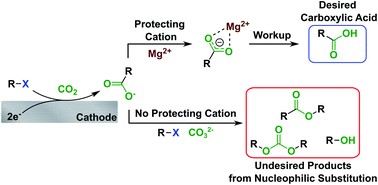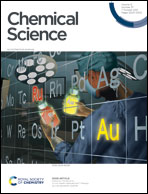Suppressing carboxylate nucleophilicity with inorganic salts enables selective electrocarboxylation without sacrificial anodes†
Abstract
Although electrocarboxylation reactions use CO2 as a renewable synthon and can incorporate renewable electricity as a driving force, the overall sustainability and practicality of this process is limited by the use of sacrificial anodes such as magnesium and aluminum. Replacing these anodes for the carboxylation of organic halides is not trivial because the cations produced from their oxidation inhibit a variety of undesired nucleophilic reactions that form esters, carbonates, and alcohols. Herein, a strategy to maintain selectivity without a sacrificial anode is developed by adding a salt with an inorganic cation that blocks nucleophilic reactions. Using anhydrous MgBr2 as a low-cost, soluble source of Mg2+ cations, carboxylation of a variety of aliphatic, benzylic, and aromatic halides was achieved with moderate to good (34–78%) yields without a sacrificial anode. Moreover, the yields from the sacrificial-anode-free process were often comparable or better than those from a traditional sacrificial-anode process. Examining a wide variety of substrates shows a correlation between known nucleophilic susceptibilities of carbon–halide bonds and selectivity loss in the absence of a Mg2+ source. The carboxylate anion product was also discovered to mitigate cathodic passivation by insoluble carbonates produced as byproducts from concomitant CO2 reduction to CO, although this protection can eventually become insufficient when sacrificial anodes are used. These results are a key step toward sustainable and practical carboxylation by providing an electrolyte design guideline to obviate the need for sacrificial anodes.

- This article is part of the themed collections: Most popular 2021 catalysis articles, 2021 and Editor’s Choice – Jinlong Gong


 Please wait while we load your content...
Please wait while we load your content...